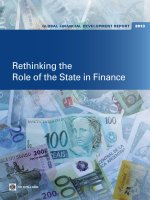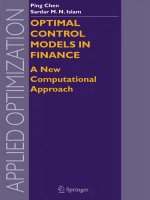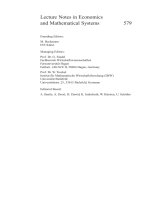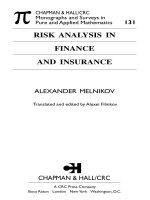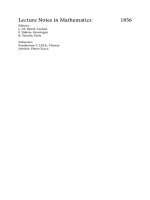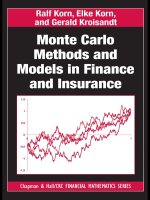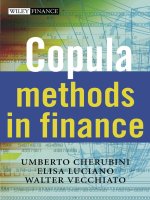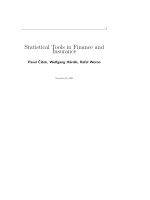Lecture note in finance 2
Bạn đang xem bản rút gọn của tài liệu. Xem và tải ngay bản đầy đủ của tài liệu tại đây (2.2 MB, 191 trang )
Lecture Notes in Finance 2 (MiQE/F, MSc course
at UNISG)
Paul Söderlind1
10 December 2013
1 University
of St. Gallen. Address: s/bf-HSG, Rosenbergstrasse 52, CH-9000 St. Gallen,
Switzerland. E-mail: Document name: Fin2MiQEFAll.TeX
Contents
12 Interest Rate Calculations
12.1 Interest Rate Conventions . . . . . . . .
12.2 Zero Coupon (discount or bullet) Bonds
12.3 Forward Rates . . . . . . . . . . . . . .
12.4 Coupon Bonds . . . . . . . . . . . . .
12.5 Swap and Repo . . . . . . . . . . . . .
12.6 Estimating the Yield Curve . . . . . . .
12.7 Conventions on Important Markets . .
12.8 Inflation-Indexed Bonds . . . . . . . .
12.9 Other Instruments . . . . . . . . . . . .
.
.
.
.
.
.
.
.
.
3
3
3
6
12
20
23
29
33
35
A More Details on Bond Conventions
A.1 Bond Equivalent Yields on US Bonds . . . . . . . . . . . . . . . . .
36
36
13 Bond Portfolios
13.1 Duration: Definitions . . . . . . . . . . . . . . . . . . . . . . . . . .
13.2 Duration Matching . . . . . . . . . . . . . . . . . . . . . . . . . . .
41
41
47
14 Interest Rate Models
14.1 Yield Curve Models . . . . . . . . . .
14.2 Interest Rates and Macroeconomics .
14.3 Forecasting Interest Rates . . . . . . .
14.4 Risk Premia on Fixed Income Markets
.
.
.
.
58
58
71
78
79
15 Basic Properties of Futures and Options
15.1 Derivatives . . . . . . . . . . . . . . . . . . . . . . . . . . . . . . .
83
83
.
.
.
.
.
.
.
.
.
.
.
.
.
.
.
.
.
.
.
.
.
.
.
.
.
.
.
.
.
.
.
.
.
.
.
.
.
.
.
.
.
.
.
.
.
.
.
.
.
.
.
.
.
.
.
.
.
.
.
.
.
.
.
.
.
.
.
.
.
.
.
.
.
.
.
.
.
.
.
.
.
.
.
.
.
.
.
.
.
.
.
.
.
.
.
.
.
.
.
.
.
.
.
.
.
.
.
.
.
.
.
.
.
.
.
.
.
.
.
.
.
.
.
.
.
.
.
.
.
.
.
.
.
.
.
.
.
.
.
.
.
.
.
.
.
.
.
.
.
.
.
.
.
.
.
.
.
.
.
.
.
.
.
.
.
.
.
.
.
.
.
.
.
.
.
.
.
.
.
.
.
.
.
.
.
.
.
.
.
.
.
.
.
.
.
.
.
.
.
1
15.2
15.3
15.4
15.5
15.6
15.7
Forward and Futures . . . . . . . . . . . . . . . .
Introduction to Options . . . . . . . . . . . . . . .
Put-Call Parity for European Options . . . . . . . .
Pricing Bounds and Convexity of Pricing Functions
Early Exercise of American Options . . . . . . . .
Put-Call Relation for American Options . . . . . .
16 The Binomial Option Pricing Model
16.1 Overview of Option Pricing . . . . . . . . . . .
16.2 The Basic Binomial Model . . . . . . . . . . .
16.3 Interpretation of the Riskneutral Probabilities .
16.4 Numerical Applications of the Binomial Model
.
.
.
.
.
.
.
.
.
.
.
.
.
.
.
.
.
.
.
.
.
.
.
.
.
.
.
.
.
.
.
.
.
.
.
.
.
.
.
.
.
.
.
.
.
.
.
.
.
.
.
.
.
.
.
.
.
.
17 The Black-Scholes Model and the Distribution of Asset Prices
17.1 The Black-Scholes Model . . . . . . . . . . . . . . . . . . .
17.2 Convergence of the BOPM to Black-Scholes . . . . . . . . .
17.3 The Probabilities in the BOPM and Black-Scholes Model .
17.4 Hedging an Option . . . . . . . . . . . . . . . . . . . . . .
17.5 Estimating Riskneutral Distributions . . . . . . . . . . . .
18 FX and Interest Rate Options
18.1 Forward Contract on a Currency . . . . . . . . . .
18.2 Summary of the Black-Scholes Model . . . . . . .
18.3 Hedging . . . . . . . . . . . . . . . . . . . . . . .
18.4 FX Options: Put or Call? . . . . . . . . . . . . . .
18.5 FX Options: Risk Reversals and Strangles . . . . .
18.6 FX Options: Implied Volatility for Different Deltas
18.7 Options on Interest Rates: Caps and Floors . . . . .
.
.
.
.
.
.
.
.
.
.
.
.
.
.
.
.
.
.
.
.
.
.
.
.
.
.
.
.
.
.
.
.
.
.
.
.
.
.
.
.
.
.
.
.
.
.
.
.
.
.
.
.
.
.
.
.
.
.
.
.
.
.
.
.
.
.
.
.
.
.
.
.
.
.
.
.
.
.
.
.
.
.
.
.
.
.
.
.
.
.
.
.
.
.
.
.
.
.
.
.
.
.
.
.
.
.
.
.
.
.
.
.
.
.
.
.
.
.
.
.
.
.
.
.
.
.
.
.
.
83
89
102
104
110
117
.
.
.
.
120
120
120
127
129
.
.
.
.
.
140
140
146
152
156
165
.
.
.
.
.
.
.
171
171
171
172
173
175
180
180
19 Trading Volatility
184
19.1 The Purpose of Trading Volatility . . . . . . . . . . . . . . . . . . . . 184
19.2 VIX and VIX Futures . . . . . . . . . . . . . . . . . . . . . . . . . . 185
19.3 Variance and Volatility Swaps . . . . . . . . . . . . . . . . . . . . . 187
2
12
Interest Rate Calculations
Main references: Elton, Gruber, Brown, and Goetzmann (2010) 21–22 and Hull (2009) 4
Additional references: McDonald (2006) 7; Fabozzi (2004); Blake (1990) 3–5; and Campbell, Lo, and MacKinlay (1997) 10
12.1
Interest Rate Conventions
Suppose we borrow one unit of currency (that is, the face value of the loan is 1) that
should be repaid with interest rate m periods later. The payment in period m is then the
face value (of 1) plus the interest, so the payment in m is
payment D Œ1 C Y.m/m
(12.1)
D 1 C mZ.m/;
(12.3)
D exp Œmy .m/
(12.2)
where Y .m/ is the effective interest rate, y .m/ the continuously compounded interest rate
and Z.m/ is the simple interest rate.
Remark 12.1 (The transformation from one type of rate to the other) We have
y .m/ D ln Œ1 C Y.m/ and y .m/ D ln Œ1 C mZ.m/ =m;
Y.m/ D exp Œy .m/
Z.m/ D fŒ1 C Y.m/m
1 and Y.m/ D Œ1 C mZ.m/1=m
1g=m and Z.m/ D fexp Œy .m/
1
1g=m:
The different interest rates (effective, continuously compounded and simple) are typically very similar, except for very high rates. See Figure 12.2 for an illustration.
12.2
Zero Coupon (discount or bullet) Bonds
Suppose a bond without dividends costs B .m/ in t and gives one unit of account in t C m
(the trade date index t is suppressed to simplify notation—in case of potential confusion,
3
t Cm
t
buy bond
for B.m/
get face
value
Figure 12.1: Timing convention of zero coupon bond
we can write B t .m/). See Figure 12.1 for an illustration.
The gross return (payoff divided by price) from investing in this bond is 1=B.m/,
since the face value is normalized to unity.
1
D Œ1 C Y.m/m , or
B .m/
Y.m/ D B.m/
1=m
(12.4)
(12.5)
1:
Another way to think of this is that if we invest the amount B.m/ by buying one bond,
then after m periods we get B.m/ times the interest rate, that is, B.m/ Œ1 C Y.m/m D 1.
In practice, bond quotes are typically expressed in percentages (like 97) of the face value,
whereas the discussion here effectively uses the fraction of the face value (like 0.97).
The relation between the rate and the price is clearly non-linear—and depends on the
time to maturity (m): short rates are more sensitive to bond price movements than long
rates. Conversely, prices on short bonds are less sensitive to interest rate changes than
prices on long bonds. See Figure 12.2 for an illustration.
In terms of the continuously compounded rate, we have
1
D exp Œmy .m/ , or
B .m/
y.m/ D
(12.6)
ln B.m/=m:
(12.7)
Example 12.2 (Effective and continuously compounded rates) Let the period length be a
year (which is the most common convention for interest rates). Consider a six-month bill
so m D 0:5. Suppose B .m/ D 0:95. From (12.4) we then have that
1
D Œ1 C Y.0:5/0:5 , so Y.0:5/
0:95
0:108; and y.0:5/
0:103:
4
Bond prices and rates
Bond price/face value, %
100
90
80
70
60
Price 2-year
Price 10-year
50
0
1
2
3
4
5
Effective interest rate, %
6
7
Figure 12.2: Interest rate vs. bond price
Example 12.3 (Bond price changes vs interest rate changes) Suppose that, over a split
second (so the time to maturity is virtually unchanged), the log bond price changes by
ln B, then (12.7) says that the change in the interest rate is
y.m/ D
ln B.m/=m:
Inverting gives
ln B.m/ D
m y.m/:
For instance, if the price of a 10-year bond decreases from 0.95 to 0.86 we get that the
interest rate increases by
ln.0:86=0:95/=10 D 0:01;
that is, from 0.5% to 1.5%. Similarly, as the rate increases with 1%, the log price changes
by
10 0:01 D 0:1:
Some fixed income instruments (in particular inter bank loans, LIBOR/EURIBOR)
are quoted in terms of a simple interest rate. The “price” of a deposit that gives unity at
5
Bond prices and rates
Difference to effective rate
1
Interest rate, %
Interest rate, %
15
10
Effective rate
Cont comp rate
Simple rate
5
0
Cont comp rate
Simple rate
0.5
0
−0.5
−1
94
96
98
100
Bond price/face value (1/2 year), %
0
5
10
Effective interest rate, %
15
Figure 12.3: Different types of interest rates
maturity is then
1
, or
1 C mZ.m/
1=B .m/ 1
:
Z.m/ D
m
B .m/ D
12.3
Forward Rates
12.3.1
Implied Forward Rates
(12.8)
(12.9)
A forward contract written in t stipulates buying at t C m, a discount bond that pays one
unit of account at time t C n—see Figure 12.5 for an illustration. An arbitrage argument
(see Figure 12.6) shows that the forward price must satisfy
forward price D B.n/=B.m/:
(12.10)
Proof. (of (12.10)) In period t, buy one bond maturing in t C n at the cost of B.n/
and sell B.n/=B.m/ bonds maturing in t C m at the value of B.n/: the net investment in
t is zero. In t C m, pay the principal of the maturing bonds at the cost B.n/=B.m/—this
is the net investment in t C m. The payoff in t C n is one. The forward contract has the
same payoff in t C n and must therefore specify the same net investment in t C m, the
forward price: B.n/=B.m/.
Buying a forward contract is effectively an investment from t C m to t C n, that
6
Returns
0
at 1% rate
at 2% rate
110
All interest rates
increase from 1%
to 2%
%
Bond price/face value, %
Prices of 2.5% coupon bonds
−5
105
100
−10
2
4
6
maturity
8
10
8
10
2
4
6
maturity
8
10
Returns
10
%
All interest rates
decrease from 2%
to 1%
5
0
2
4
6
maturity
Figure 12.4: Gains and losses at interest rate changes
is, over n m periods. The gross return (which happens to be known already in t ) is
1=ŒB.n/=B.m/. We define a per period effective rate of return, a forward rate, F .m; n/,
analogous with (12.4)
1
D Œ1 C F .m; n/n
B.n/=B.m/
m
(12.11)
:
Notice that F .m; n/ here denotes a forward rate, not a forward price. This is the rate
of return over t C m to t C n that can be guaranteed in t . By using the relation between
bond prices and yields (12.4) this expression can be written
Ä
B.m/
F .m; n/ D
B.n/
1=.n m/
1D
Œ1 C Y.n/n=.n
Œ1 C Y.m/m=.n
m/
m/
1:
(12.12)
See Figure 12.7 for an illustration.
7
t Cm
t
write contract:
agree on
forward price
t Cn
pay forward
price, get bond
bond
matures
Figure 12.5: Timing convention of forward contract
t Cm
t
buy 1 n-bond,
sell B.n/=B.m/
of m-bonds
t Cn
get the
face value
pay B.n/=B.m/
the face value
Figure 12.6: Synthetic forward contract
Remark 12.4 (Alternative way of deriving the forward rate ) Rearrange (12.12) as
Œ1 C Y.m/m Œ1 C F .m; n/n
m
D Œ1 C Y.n/n :
This says that compounding 1 C Y.m/ over m periods and then 1 C F .m; n/ for n m
periods should give the same amount as compounding the long rate, 1 C Y.n/, over n
periods.
Split up the time until n into n= h intervals of length h (see Figure 12.8). Then, the
n-period spot rate equals the geometric average of the h-period forward rates over t to
t Cn
1 C Y.n/ D Œ1 C F .0; h/h=n Œ1 C F .h; 2h/h=n
Yn=m 1
D
f1 C F Œsh; .s C 1/hgh=n :
sD0
:::
Œ1 C F .n
h; n/h=n
(12.13)
This means that the forward rate can be seen as the “marginal cost” of making a loan
8
Spot and forward rates
Effective interest rate, %
7
spot, 2Q
spot, 3Q
forward
6.5
6
5.5
5
4.5
4
3.5
0.25
0.5
Maturity, years
0.75
1
Figure 12.7: Spot and forward rates
forward
0
forward
h
forward
2h
:::
3h
n
n-period spot rate
Figure 12.8: Forward contracts for several future periods
longer. See Figure 12.9 for an illustration.
Proof. (of (12.13)) Let n D 2m and use (12.11) for forward contracts between 0 to m
and m to 2m
1
1
D Œ1 C F .0; m/m and
D Œ1 C F .m; 2m/m :
B.m/=B.0/
B.2m/=B.m/
Multiply and simplify to get
1
D Œ1 C F .0; m/m
B.n/
Œ1 C F .m; 2m/m :
9
Flat yield curve
8
6
6
Int rate, %
Int rate, %
Upward sloping yield curve
8
4
Spot
Forward (one-period)
2
0
4
2
0
2
4
6
Maturity
8
10
2
4
6
Maturity
8
10
Downward sloping yield curve
Int rate, %
8
6
4
2
0
2
4
6
Maturity
8
10
Figure 12.9: Spot and forward rates
Raise to the power of 1=n to get the interest rate
1 C Y.n/ D Œ1 C F .0; m/m=n
Œ1 C F .m; 2m/m=n :
Example 12.5 (Forward rate) Let m D 0:5 (six months) and n D 0:75 (nine months),
and suppose that Y.0:5/ D 0:04 and Y.0:75/ D 0:05. Then (12.12) gives
Œ1 C F .0:5; 0:75/0:75
which gives F .0:5; 0:75/
0:5
D
.1 C 0:05/0:75
;
.1 C 0:04/0:5
0:07. See Figure 12.7 for an illustration.
Example 12.6 (Forward rate) Let the period length be a year. Let m D 1 (one year) and
10
n D 2 (two years), and suppose that Y.1/ D 0:04 and Y.2/ D 0:05. Then (12.12) gives
.1 C 0:05/2
F .1; 2/ D
.1 C 0:04/1
1
0:06:
Example 12.7 (Spot as average forward rate) In the previous example, (12.13) gives,
using F .0; 1/ D Y.1/,
1:041=2 1:061=2 1:05;
which indeed equals 1 C Y.2/.
Remark 12.8 (Forward Rate Agreement) An FRA is an over-the-counter contract that
guarantees an interest rate during a future period. The FRA does not involve any lending/borrowing—
only compensation for the deviation of the future interest rate (typically LIBOR) from the
agreed forward rate. An FRA can be emulated by a portfolio of zero-coupon bonds, similarly to a forward contract.
12.3.2
Continuously Compounded and Simple Forward Rates
Taking logs of 1 C F .m; n/ in (12.12) we get the continuously compounded forward rate
f .m; n/ D
1
n
m
ln
B.m/
ny.n/
D
B.n/
n
my.m/
:
m
(12.14)
Conversely, the n-period (continuously compounded) spot rate equals the average (continuously compounded) forward rate (take logs of 12.13)
y .m/ D
h Xn= h
sD0
n
1
f Œsh; .s C 1/h:
(12.15)
A simple forward rate (used on interbank markets) is defined as
1
D 1 C .n m/Z f .m; n/, so
B.n/=B.m/
Ä
1
B.m/
nZ.n/ mZ.m/
f
Z .m; n/ D
1 D
:
n m B.n/
.n m/Œ1 C mZ.m/
12.3.3
(12.16)
(12.17)
Instantaneous Forward Rates
The instantaneous forward rate, f .m/, is defined as the limit when the maturity date of
the bond approaches the settlement date of the forward contract, n ! m. This can be
11
c
m1
0
c
m2
cC1
mK
Figure 12.10: Timing convention of coupon bond
thought of as a forward “overnight” rate m periods ahead in time. From (12.14) it is
f .m/ D lim f .m; n/
n!m
m Œy.m/ y.n/
m
y.n/ lim
n!m
m
n m
dy.m/
D y.m/ C m
:
dm
(12.18)
n
n!m n
D lim
(12.19)
Conversely, the average of the forward rates over t to t C n is the spot rate, which we see
by integrating (12.19) to get
Z
1 n
f .s/ds:
(12.20)
y .n/ D
n 0
Equations (12.19) and (12.20) show that the difference between the forward and spot
rates, f .n/ y.n/, is proportional to the slope of the yield curve.
Proof. (of (12.20)) Integrating the first term on the right hand side of (12.19) over
Rn
Œ0; n gives 0 y.s/ds. Integrating (by parts) the second term on the right hand side of
Rn
Rn
(12.19) over Œ0; n, 0 s dy.s/
ds,
gives
ny.n/
0 y.s/ds. Adding the two terms gives
ds
ny.n/.
12.4
Coupon Bonds
12.4.1
Bond Basics
Consider a bond which pays coupons, c, for K periods (t C m1 , t C m2 ,.. ), and one unit
of account (the “face” or “par” value) in the last period t C mK —see Figure 12.10.
The coupon bond is, in fact, a portfolio of zero coupon bonds: c maturing in t C m1 ,
c in t C m2 ,..., and 1 in t C mK . The price of the coupon bond, B .K; c/, must therefore
12
equal the price of the portfolio
B .K; c/ D
PK
kD1 B.mk /c
(12.21)
C B.mK /
where B.m/ is the price of a zero coupon bond. Using the relation between (zero coupon)
bond prices and yields in (12.4), this can also be written
B .K; c/ D
PK
kD1
c
1
:
mk C
Œ1 C Y.mk /
Œ1 C Y.mK /mK
(12.22)
Example 12.9 (Coupon bond price) Suppose B.1/ D 0:95 and B.2/ D 0:90. The price
of a bond with a 6% annual coupon with two years to maturity is then
1:01
0:95
0:06 C 0:90
Equivalently, the bond prices imply that Y.1/
1:01
0:06 C 0:90:
5:3% and Y.2/
5:4% so
0:06 C 1
0:06
C
:
1:053
1:0542
Example 12.10 (Coupon bond price at par) A 9% (annual coupons) Suppose B.1/ D
1=1:06 and B.2/ D 1=1:0912 . The price of a bond with a 9% annual coupon with two
years to maturity is then
0:09
1
0:09
C
C
2
1:06 1:091
1:0912
1:
This bond is (approximately) sold “at par”, that is, the bond price equals the face (or
par) value (which is 1 in this case).
If we knew all the spot interest rates, then it would be easy to calculate the correct
price of the coupon bond. The special (admittedly unrealistic) case when all spot rates are
the same (flat yield curve) is interesting since it provides good intuition for how coupon
bond prices are determined. In partcular, if the next coupon payment is one period ahead
(mk D k), then (12.22) becomes
B .K; c/ D 1 C
c
Y
Y h
1
.1 C Y /
K
i
;
(12.23)
where Y is the (common) spot rate. The term in square brackets is positive (for K > 0),
so when the interest rate (which then equals the yield to maturity, see below) is below the
13
coupon rate, then the bond price is above the face value (since c Y > 0)—and vice
versa. See Figure 12.11 for an illustration.
However, the situation is typically the reverse: we know prices on several coupon
bonds (different maturities and coupons), and want to calculate the spot interest rates that
are compatible with them. This is to estimate the yield curve. The implied zero coupon
bonds prices is often called the discount function.
Remark 12.11 (STRIPS, Separate Trading of Registered Interest and Principal of Securities) A coupon bond can be split up into its embedded zero coupon bonds—and traded
separately. STRIPS are therefore zero coupon bonds.
12.4.2
Yield to Maturity
The effective yield to maturity (also called redemption yield), Â, on a coupon bond is the
internal rate of return which solves
B .K; c/ D
PK
kD1
1
c
;
mk C
.1 C Â/
.1 C Â/mK
(12.24)
where the bond pays coupons, c, at m1 ; m2 ; :::; mK periods ahead. This equation can be
solved (numerically) for Â. Quotes of bonds are typically the yield to maturity or the
price. For a par bond (the bond price equals the face value, here 1), the yield to maturity
equals the coupon rate. For a zero coupon bond, the yield to maturity equals the spot
interest rate.
Example 12.12 (Yield to maturity) A 4% (annual coupon) bond with 2 years to maturity.
Suppose the price is 1.019. The yield to maturity is 3% since it solves
1:019
0:04
0:04
1
C
C
:
2
1 C 0:03 .1 C 0:03/
.1 C 0:03/2
Example 12.13 (Yield to maturity of a par bond) A 4% (annual coupon) par bond (price
of 1)with 2 years to maturity. The yield to maturity is 4% since
0:04
0:04
1
C
C
D1
2
1 C 0:04 .1 C 0:04/
.1 C 0:04/2
Example 12.14 (Yield to maturity of a portfolio) A 1-year discount bond with a ytm (effective interest rate) of 7% has the price 1=1:07 and a 3-year discount bond with a ytm of
14
Bond prices at different yields to maturity
Bond price/face value, %
120
2.5%
5%
7.5%
115
110
The bond pays a 5% coupon at the beginning
of year 1,2,..,10
105
100
The bond prices in year 1,2,...,10 are measured
directly after the coupon payment
95
90
85
0
2
4
6
8
10
year
Figure 12.11: Bond price and yield to maturity
10% has the price 1=1:13 . A portfolio with one of each bond has a ytm
1
1
1
1
C
D
C
, with Â
1:07 1:13
1CÂ
.1 C Â/3
0:091:
This is clearly not the average ytm of the two bonds. It would be, however, if the yield
curve is flat.
Note that the yield to maturity is just a convention. In particular, it does not provide a
measure of the return to an investor who buys the bond and keeps it until maturity—unless
the investor can reinvest all coupons to the same interest rate as the ytm of the bond. If
the yield curve is flat, then that can be done by forward contracts or swaps. If the yield
curve is not flat, then the rates at which the coupons are reinvested are typically different
from the ytm of the bond—so the overall return of holding the bond will also be.
12.4.3
The Return of Holding a Coupon Bond until Maturity
To calculate the buy-and-hold (until maturity) return of a coupon bond we need to specify
how the coupons are reinvested. One useful assumption is that the coupons are reinvested
via forward contracts. This means that the investor buys the bond now and receives nothing until maturity—as if he/she had bought a zero-coupon bond. Indeed, no-arbitrage
15
arguments show that the return (from now to maturity) is indeed the spot interest on a
zero-coupon bond.
Proof. (Buy-and-hold return on a coupon bond, simple case) Consider a 3-period
coupon bond. From (12.22), the price of the bond is
B .K; c/ D B.1/c C B.2/c C B.3/c C B.3/:
From (12.11), we know that the forward contract for the first coupon has the gross return
(until maturity) 1=ŒB.3/=B.1/ and that the forward contract for the second coupon has
the cross return (until maturity) 1=ŒB.3/=B.2/. The value of the reinvested coupons and
the face value at maturity is then
B.1/
B.2/
cC
c C c C 1:
B.3/
B.3/
Dividing by the first equation (the investment) gives 1=B.3/ so the return on buying and
holding (and reinvesting the coupons) this coupon bond is the same as the 3-period spot
interest rate. (The extension to more periods is straightforward.)
Example 12.15 (Yield to maturity versus return) Suppose also that the spot (zero coupon)
interest rates are 4% for one year to maturity and 9% for 2 years to maturity. Notice that
the forward rate (between year 1 and 2) is 14.24%. A 3% coupon bond with 2 years to
maturity must have the price
0:03 0:03 C 1
C
1:04
1:092
0:8958:
The yield to maturity is 8.91% since
0:8958
0:03
0:03 C 1
C
:
1 C 0:0891 .1 C 0:0891/2
However, the value of the bond at maturity, if the coupon is reinvested by a forward
contract, is
0:03 .1 C 0:1424/ C 0:03 C 1 1:0643;
p
so the gross return over two years is approximately 1:0643=0:8958. Annualized ( 1:0643=0:8958)
this becomes 1.09 so the effective annual return is 9%—just like the 2-year spot rate.
16
12.4.4
Calculating the Yield to Maturity
Remark 12.16 (Calculating  in a simple case) If mk in (12.24) is the integer k, then
subtracting B from both sides of (12.24) gives a K t h order polynomial in D 1=.1 C Â/,
0D
BC
PK
1
kD1 c
k
C .c C 1/
K
;
where all coefficients except one are positive. There is then only one positive real root,
1 . Many software packages contain routines for finding roots of polynomials. Once that
is done, pick the only positive real root, 1 , and calculate the yield as  D .1
1 /= 1 .
Remark 12.17 (Calculating  in the simplest case) If the bond price, B, is unity, then the
bond is sold “at par.” If also mk in (12.24) is the integer k (as in the previous remark),
then  D c.
Example 12.18 (Par bond) A 9% (annual coupons) 2-year bond with a yield to maturity
of 9%, and exactly two years to maturity has the price
0:09
1
0:09
C
D 1:
C
1 C 0:09 .1 C 0:09/2
.1 C 0:09/2
Remark 12.19 (Newton-Raphson algorithm for solving (12.24)) It is straightforward to
use a Newton-Raphson algorithm to solve (12.24). It is then useful to note that the derivative is
PK
dB.Â/
mk c
mK
D
:
kD1
mk C1
dÂ
.1 C Â/
.1 C Â/mK C1
The Newton-Raphson algorithm is based on a first order Taylor expansion of the bond
price equation
dB.Â0 /
.Â1 Â0 / :
B.Â1 / D B.Â0 / C
dÂ
Set the left hand side equal to the observed price, B, guess a values of  and call it Â0 ;
0/
then solve for Â1 as Â1 D Â0 C ŒB B.Â0 / = dB.Â
. Â1 is probably a better guess of Â
dÂ
1/
than Â0 . Improve by repeating this updating as Â2 D Â1 C ŒB B.Â1 / = dB.Â
, and so
dÂ
forth until Ân converges.
Remark 12.20 (Bisection method for solving (12.24)) The bisection method is a very
simple (no derivatives are needed) and robust way to solve for the yield to maturity. First,
start with a lower (ÂL ) and higher (ÂH ) guess of the yield which are known to bracket the
17
true value, that is, B.ÂH / Ä B Ä B.ÂL / where B is the observed bond price and B.Â/ is
the value according to (12.24). Recall that B.Â/ is decreasing in Â. Second, calculate the
bond price at the average of the two guesses: BŒ.ÂL C ÂH /=2. Third, replace either ÂL
or ÂH according to: if BŒ.ÂL C ÂH /=2 B (so the midpoint .ÂL C ÂH /=2 is below the
true yield) then replace ÂL by .ÂL C ÂH /=2 (a higher value), but if BŒ.ÂL C ÂH /=2 < B
then replace ÂH by .ÂL C ÂH /=2 (a lower value). Fourth, iterate until ÂL ÂH .
Example 12.21 (Bisection method). The first couple of iterations for a 2-year bond with
a 4% coupon and a price of 1.019 are (see also Figure 12.12)
Bisection: yield bounds and mid point
6
6
Newton-Raphson: yield guess
4
4
yield
yield
Iteration
ÂL
ÂH
.ÂL C ÂH /=2 BŒ.ÂL C ÂH /=2
1
0
0:05
0:0250
1:0289
2
0:025
0:05
0:0375
1:0047
3
0:025
0:0375
0:03125
1:0167
4
0:025
0:03125
0:028125
1:0228
5
0:028125 0:03125
0:029687
1:0197
2
2-year bond, 4% coupon, price 1.019
Convergence critierion: 1e-05
0
0
5
10
iteration
15
2
0
0
5
10
15
iteration
Figure 12.12: Bisection method to calculate yield to maturity
12.4.5
Par Yield
A par yield for is the coupon rate at which a bond would trade at par (that is, have a price
equal to the face value). Setting B .K; c/ D 1 in (12.21) and solving for the implied
18
coupon rate gives
c D PK
1
kD1 B.mk /
1
D PK
1
Œ1
kD1 Œ1CY .mk /mk
B.mK / , or
(12.25)
Ä
(12.26)
1
1
:
Œ1 C Y.mK /mK
Typically, this is very similar to the zero coupon rates.
Example 12.22 Suppose B.1/ D 0:95 and B.2/ D 0:90. We then have
1 D .0:95 C 0:9/c C 0:9, so c D
1
.1
0:95 C 0:9
8
6
6
4
Spot
Par yield
2
0:054:
Flat yield curve
8
Int rate, %
Int rate, %
Upward sloping yield curve
0:9/
0
4
2
0
2
4
6
Maturity
8
10
2
4
6
Maturity
8
10
Downward sloping yield curve
Int rate, %
8
6
4
2
0
2
4
6
Maturity
8
10
Figure 12.13: Spot and par yield curve
19
Interest rate swap
Company
Bank
7% on EUR 100
(each year)
Libor on EUR 100
(each year)
Figure 12.14: Interest rate swap
12.5
Swap and Repo
12.5.1
Swap
A swap contract involves a sequence of payment over the life time (maturity) of the contract: for each tenor (that is, sub period, for instance a quarter) it pays the floating market
rate (say, the 3-month Libor) in return for a fixed swap rate. Split up the time until maturity n into n= h intervals of length h—see Figure 12.15. In period sh, the swap contract
pays
hŒZ.s 1/h .h/ R
(12.27)
where Z.s 1/h .h/ is the short (floating) simple h-period interest rate in .s 1/h and R is
the (fixed) swap rate determined in t (as part of the swap contract).
The issuer can lock in the floating rate payments by a sequence of forward rate agreements that pay the floating rate in return for the forward rate. In this way the swap contract
becomes riskfree so its present value must be zero. This implies that the swap rate must
therefore be (assuming no default or liquidity premia)
RD
1 1 B.n/
;
h Xn= h
B.sh/
(12.28)
sD1
20
swap rate
floating rate
C
0
h
2h
C
3h
4h
(The party receiving the floating rate pays the fixed swap rate)
(The net payments are marked by C or )
Figure 12.15: Timing convention of interest rate swap
which is proportional to the par yield in (12.25).
Example 12.23 (Swap rate) Consider a one-year swap contract with quarterly periods
(n D 1; h D 1=4). (12.28) is then
RD4
1 B.1/
:
B.1=4/ C B.1=2/ C B.3=4/ C B.1/
With the bond prices (0.99,0.98,0.97,0.96) we have
RD4
1 0:96
0:99 C 0:98 C 0:97 C 0:96
4:1%:
An Overnight Indexed Swap (OIS) is a swap contract where the floating rate is tied to
an index of floating rates (for instance, federal funds rates in the U.S., EONIA in Europe—
which is a weighted average of all overnight unsecured interbank lending transactions).
Since the OIS has very little risk (as the face value or notional never changes hands—
only the interest payment is risked in case of default), it is little affected by interbank risk
premia. The quote is in terms of the fixed rate (called the swap rate, quoted a simple
interest rate)—which typically stays close to secured lending rates like repo rates.
Proof. (of (12.28)) Notice that a simple forward rate for an investment from sh to
.s C 1/h is
Ä
B.sh/
1
f
Z Œsh; .s C 1/h D
1 :
h BŒ.s C 1/h
21
We can therefore write the present value of (12.27) as
Ä
Xn= h
BŒ.s 1/h
PV D
B.sh/
sD1
B.sh/
1
hR :
Since it is riskfree (assuming no default and liquidity premia) the PV should be zero (or
else there are arbitrage opportunities), which we rearrange as
Ä
Xn= h
Xn= h
BŒ.s 1/h
hR
B.sh/ D
B.sh/
1
sD1
sD1
B.sh/
Xn= h
hR
B.sh/ D 1 B.n/;
sD1
where we have used the fact that B.0/ D 1. Finally, solve for hR to get (12.28).
12.5.2
Repo
A Repo (Repurchase agreement) is a way of borrowing against a collateral. Suppose bank
A sells a security to bank B, but there is an agreement that bank A will buy back the
security at some fixed point in time (the next day, after a week, etc.)—at a price that is
predetermined (or decided according to some predetermined formula). This means that
bank A gets a loan against a collateral (the asset)—and pays an interest rate (final buy
price/initial sell price minus one). See Figure 12.16. Bank B is said to have made a
reverse repo. Another way to think about the repo is that bank A has made a sale of
the security, but also acquired a forward contract on it (the position of bank B is just the
reverse). The repo clearly means that bank B has “borrowed” the security—which can
then be sold to someone else. This is a way of shortening the security, so the repo rate is
low if there is a demand for shortening the security. A haircut (of 3%, say) means that the
collateral (security) has market value that is 3% higher than the price agreed in the repo.
This provides a safety margin to the lender—since the market price of the security could
decrease over the life span of the repo.
Example 12.24 (Long-short bond portfolio). First, buy bond X and use it as collateral
in a repo (the repo borrowing finances the purchase of the bond). Second, enter a reverse
repo where bond Y is used as collateral and sell the bond (selling provides cash for the
repo lending).
22
Repo
Bank A
(seller)
(borrower)
asset
(at start)
USD 100
(at start)
Bank B
(buyer)
(lender)
asset
(at end)
USD 100 + 5%
(at end)
Figure 12.16: Repo
12.6
Estimating the Yield Curve
The (zero coupon) spot rate curve is of particular interest: it helps us price any bond or
portfolio of bonds—and it has a clear economic meaning (“the price of time”).
In some cases, the spot rate curve is actually observable—for instance from swaps
and STRIPS. In other cases, the instruments traded on the market include some zero
coupon instruments (bills) for short maturities (up to a year or so), but only coupon bonds
for longer maturities. This means that the spot rate curve needs to be calculated (or
estimated). This section describes different methods for doing that.
12.6.1
Direct Calculation of the Yield Curve (“Bootstrapping”)
We can sometimes calculate large portions of the yield curve directly from asset prices.
The idea is to calculate a short yield first (from a bill/bond with short time to maturity)
and then use this to calculate the yield for the next (longer) bond, and so on.
For instance, suppose we have a one-period coupon bond, which by (12.21) must have
23
the price
(12.29)
BŒ1; c.1/ D B.1/Œc.1/ C 1;
where we use c.1/ to indicate the coupon value of this particular bond. The equation
immediately gives the one-period discount function value, B.1/. Suppose we also have a
two-period coupon bond, which pays the coupon c.2/ in t C 1 and t C 2 as well as the
principal in t C 2, with the price (see (12.21))
(12.30)
BŒ2; c.2/ D B.1/c.2/ C B.2/Œc.2/ C 1:
The two period discount function value, B.2/, can be calculated from this equation since
it is the only unknown. We can then move on to the three-period bond,
BŒ3; c.3/ D B.1/c.3/ C B.2/c.3/ C B.3/Œc.3/ C 1
(12.31)
to calculate B.3/, and so forth. Finally, we can use (12.4) to transform these zero coupon
bond prices to spot interest rates.
Remark 12.25 (Numerical calculation of the bootstrap) Equations (12.29)–(12.31) can
clearly be written
2
3 2
32
3
BŒ1; c.1/
c.1/ C 1
0
0
B.1/
6
7 6
76
7
c.2/ C 1
0
4BŒ2; c.2/5 D 4 c.2/
5 4B.2/5 ;
BŒ3; c.3/
c.3/
c.3/
c.3/ C 1
B.3/
which is a recursive (triangular) system of equations.
Example 12.26 (Bootstrapping) Suppose we know that B.1/ D 0:95 and that the price
of a bond with a 6% annual coupon with two years to maturity is 1.01. Since the coupon
bond must be priced as
0:95
0:06 C B.2/
0:06 C B.2/ D 1:01;
we can solve for the price of a two-period zero coupon bond as B.2/
interest rates are then Y.1/ 0:053 and Y.2/ 0:054.
0:90. The spot
Unfortunately, the bootstrap approach is tricky to use. First, there are typically gaps
between the available maturities. On way around that is to interpolate. Second (and
24
